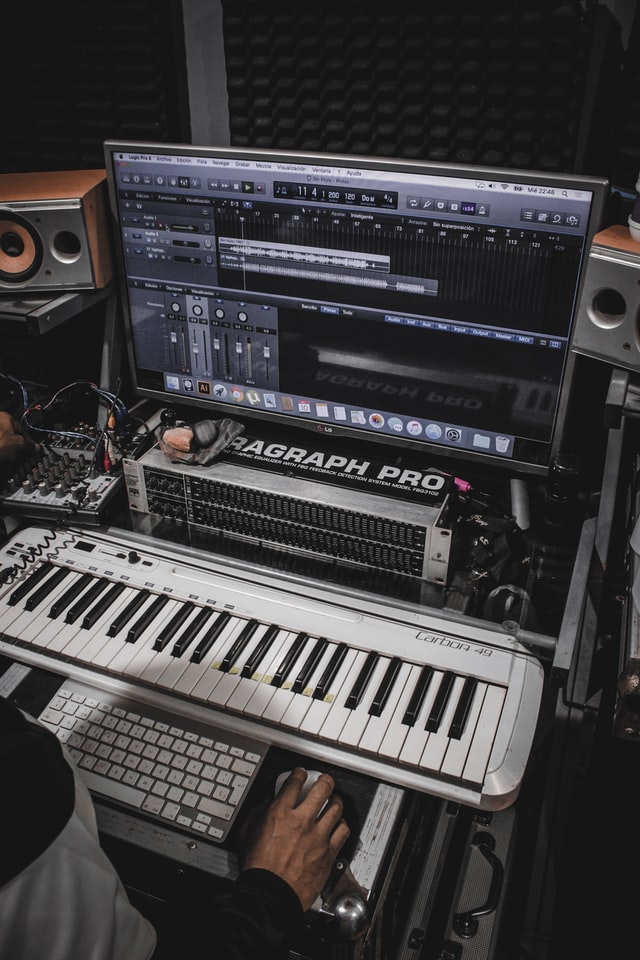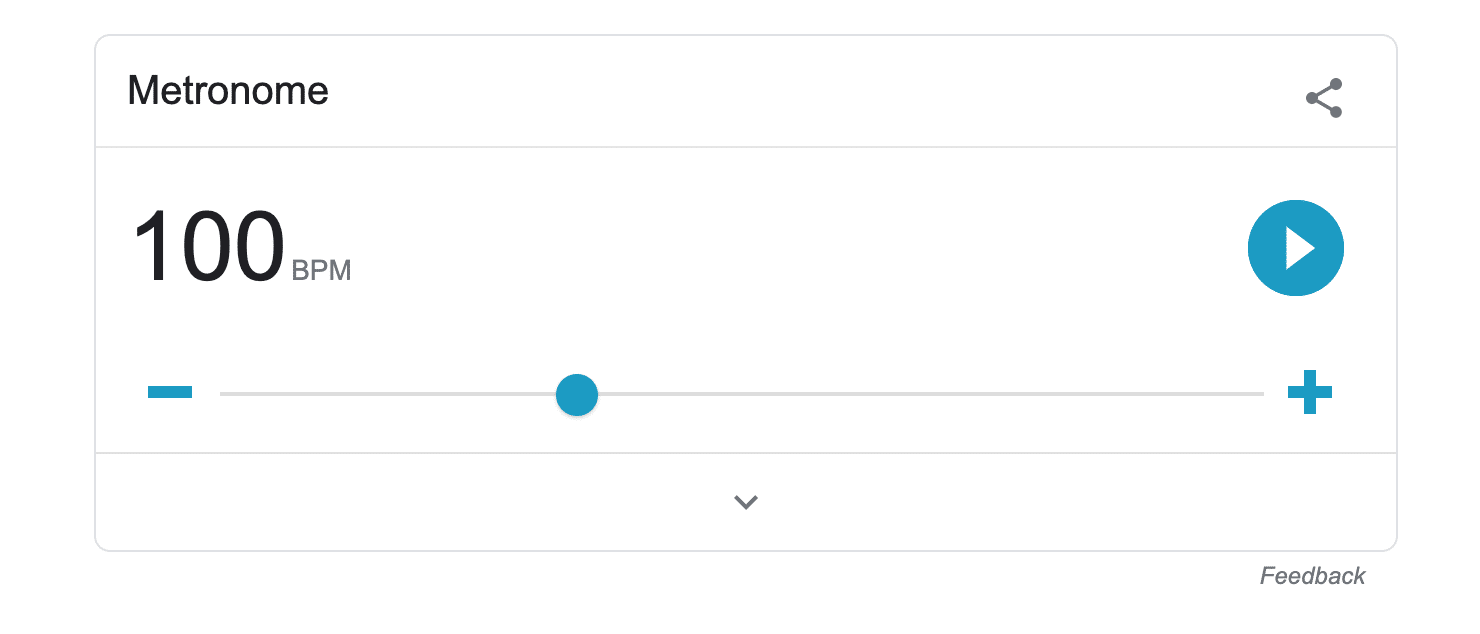Do you need a metronome for piano practice? What does a metronome do? How can it help you to practice and will it make things easier, or more difficult?
There are a lot of questions a newbie might have. People who first start to learn how to play piano may not even be totally aware of what a metronome is when they first start out. A metronome isn’t always 100% essential, but for those who want to get used to playing along with other musicians, it might be a good idea to have a go at playing in time.
It can feel like you have enough on your plate when you are starting to learn how to play piano, and that having to worry about the tick-tock of a metronome is an extra hassle, but if you want to build the right habits as a musician then it makes sense to play in time.
What is a Metronome?
Metronomes are devices that tick along in time with the music. Instead of counting 1, 2, 3, 4 in your head throughout the song, the metronome will do it for you. Plus, the metronome does it perfectly. This means that with a metronome for piano you get used to playing along with the rhythm and, in theory, play perfectly in time.
Metronomes are not new devices, but in the modern age, we have digital metronomes whereas historically we’d have been stuck with just mechanical ones. Wind-up metronomes can be traced back to 1815!
Think of your metronome as like having a drummer playing a very simple rhythm alongside your piano practice. You can make sure the melodies and chord changes are in time with the track, so that when the time comes to play with other musicians in the room, you are ready.
Finding the Tempo
If you can read music, or you plan to learn how to read music, finding the tempo will be as simple as a numeric value on the sheet music, measured in BPM. This stands for “beats per minute”.
If you don’t know the tempo of the piece of music, or want to slow it down to play in your own time and get your knowledge pegged before playing more quickly, then you can use “tap” tempo. A tap tempo function means what you would expect. You tap in the first few measures and the metronome will continue to play a rhythm with the same tempo.
For example, take this version of “You Are My Sunshine“. It is in a simple 4/4 time signature. Once you have learned the notes and chords, you can practice playing in the right time. Set the BPM to 72 first, or tap it to a speed you feel you can comfortably keep up with.
A more obscure song can sometimes be found with a simple google search. Search for the song title + BPM and you may find information about the track. If this can’t be found, tap tempo features become your best friend, as you can tap along with the original song.
It is often okay to slightly tweak the tempo of songs, especially when you are just practicing and learning how to play something. The important thing is that you can play in time.
What Tempo Means – Understanding Different Tempos
Many metronomes that you buy or use online have the capacity to use multiple tempos. Italian words are used to describe the tempo, and this music technology is a worldwide language. You don’t always hear these terms in popular music, they are more common in classical music. If you want to train to be a concert pianist, you will need to understand them.
Larghissimo—incredibly slow (20 BPM and below)
Grave—slow and often sad (20–40 BPM)
Lento—slowly (40–60 BPM)
Largo—the most common of the “slow” tempo types (40–60 BPM)
Larghetto—a sort of in-between tempo that is still slow(60–66 BPM)
Adagio—a slow but popular tempo (66–76 BPM)
Adagietto—getting a bit quicker, these are ‘hip hop’ realms in some modern music (70–80 BPM)
Andante—a popular tempo that the Italian word means “at a walking pace” (76–108 BPM)
Andantino—the quicker end of Andante
Moderato—translates as being “moderate” tempo. In modern terms, more hip hop and some slower dance music is at this tempo (108–120 BPM)
Allegretto—getting faster now
Allegro moderato—moderately fast is what this actually means (112–124 BPM)
Allegro—this is around the heartbeat tempo, and dance music is at this tempo (120–168 BPM)
Vivace—lively and quick,, this is where drum and bass would be (168-176 BPM)
Allegrissimo—very fast
Presto—hey, presto. This is “very fast” and a common tempo in the quicker parts of classical songs
Prestissimo—you will need this incredibly rarely (over 200 BPM)
Using a Metronome For Piano Online
You can also find piano Metronomes online. These give you a method of staying in time by using your browser, and websites simply trigger a metronome sound at the right tempo.
As well as options like this one, Google has its own metronome function. Yes, really. You can search for “Metronome Online” on Google. You’ll see a metronome pop up. Instead of having to wade through results, you can use Google’s own tool to stay in time.
YouTube Metronome For Piano
It seems like a crazy way of doing things when you can buy a metronome or access on in your app. Actually, if you’re already in the YouTube app then just searching the term “metronome” can bring up a load of results.
Check out this video below. That’s right, it’s just 30 minutes of a metronome ticking at 80 BPM.
The fact that this has over four million views shows you how popular YouTube is for those who want a metronome. If you’re just looking for a way to stay in time then it can be a fantastic option.
YouTube Metronome Vs. Backing Track
Another method of staying in time, besides a metronome, is a backing track. A quick search on YouTube will also bring plenty of these.
They tend to be divided by tempo, but don’t forget that backing tracks may also include instruments. If there is a bass line, for example, you need to make sure you pick a backing track that is in the right key you want to play in.
You can read more about establishing the key of a song or playing by ear here.
If you are just looking to get a drum backing track to play piano to, you don’t need to worry too much about key. Instead, you can simply load up a track in the right tempo and start playing.
Playing Songs at Different Tempos
Tempo is a changeable thing. You don’t have to play a song at the same tempo every single time.
When a band takes to a stage they may play songs a little bit quicker naturally, because their adrenaline is pumping and they are on a bit of a “high”. This can lead to rushing through the first couple of songs. Next time you are at a gig make sure you look out for this. If you’re the one playing piano, a metronome can actually be a way to stay in time if you find yourself becoming quicker naturally, so it ends up giving a much more professional end result.
When using a metronome live, you may also find any LED light features to be really useful. Sometimes, these will flash along with the song to help you to stay perfectly in time, and even if you can’t hear the metronome, you can use the flashing to help your rhythm.
Conclusion
A metronome for piano can help you to stay in time, and improve your knowledge of music overall. It can feel intimidating for beginners trying to get used to playing in time and learning about tempo, but it is an important skill. Your metronome will probably become one of your most treasured accessories.
There is nothing to be ashamed of when using a metronome, even if you are an established player. Even exceptional concert pianists will often use a metronome to practice and get to the point where they play perfectly in time, or may even have a “click track” in their ears while they are playing.
Whether you use a metronome or not is a matter of personal preference but there’s no denying that it is a useful tool and something that you should try at some stage to see if it aids your playing.
FAQs
Here are some answers to the most frequently asked questions about metronomes for piano:
Should I Buy a Metronome or Use an App?
There is a decision to make once you have set your sights on using a metronome. You can buy a metronome, which can be used as a standalone product, or you can use a metronome app. An app is cheaper, but it is very annoying if you’re in the middle of playing and the battery dies, or you get a message alert!
A standalone metronome for piano doesn’t have to be expensive, and buying one can free up your phone or tablet for other things.
What is The Best Metronome For Piano?
If you are looking for a metronome that is digital in nature then the “KLIQ MetroPitch – Metronome Tuner for All Instruments” is a great option.
If you have other instruments it will help you to tune them, but for most of us playing piano, the MetroPitch is useful because it allows us to use lots of different tempos and comes with an intuitive JOG Dial to dial in your desired tempo incredibly easly. This can be done in between songs, for example.
There are some old-fashioned wind-up metronomes, too. There is a cool guide on how they work here. The benefit of this type of metronome is the fact that you don’t have to worry about the battery dying during use, as you can just make sure it is wound and ready first.
Is a Metronome Necessary for Piano?
A metronome isn’t always necessary for learning how to play the piano. However, if you want to get good at playing in time and becoming a better all-round musician then being able to play to a metronome is an important skill.
We’d always recommend trying to get used to playing in time, and this means a metronome is an incredibly useful tool for your playing.
Do Professional Musicians Use a Metronome?
A lot of professional musicians use a metronome, as it can help to keep time even if your adrenaline is flowing on stage. Even professional musicians may need some help staying perfectly in time.
Can I Use My Phone as a Metronome?
Using either a metronome app or just typing “metronome” into Google you can use your phone to help you to keep time and provide a metronome or click track, so you don’t have to carry around a specific device if you don’t want to.
A lot of metronome apps have their own set of features including different time signatures and plenty of speeds.
Why Does a Metronome Have a Bell?
A lot of metronomes have bells to help to mark or accent a certain beat, for instance the first beat of a bar. This helps you to keep track of which bar you have reached in the music and not lose the “1” when counting 1, 2, 3, 4.
What Do the Numbers Mean on a Metronome?
The numbers are simply a way for you to check what the BPM or “beats per minute” is currently set to. The higher the number, the faster the beat. Song info including their sheet music or tablature may tell you the metronome speed or tempo that the song should be played at.
Should You Practice Piano With a Metronome?
Playing with a metronome is a way to ensure that you learn to play properly in time, which is more professional as well as being very helpful and useful if you plan to start playing with other musicians. This is when you will need to perfectly time your playing.
How Should I Use a Metronome?
Simply set the metronome to the right time signature and tempo and start it ticking! This may mean pressing start on a digital model or winding up the metronome if it is an older, analog model. Apps also have their own controls which may vary. Once the metronome is ticking along, use it as reference for your playing.












